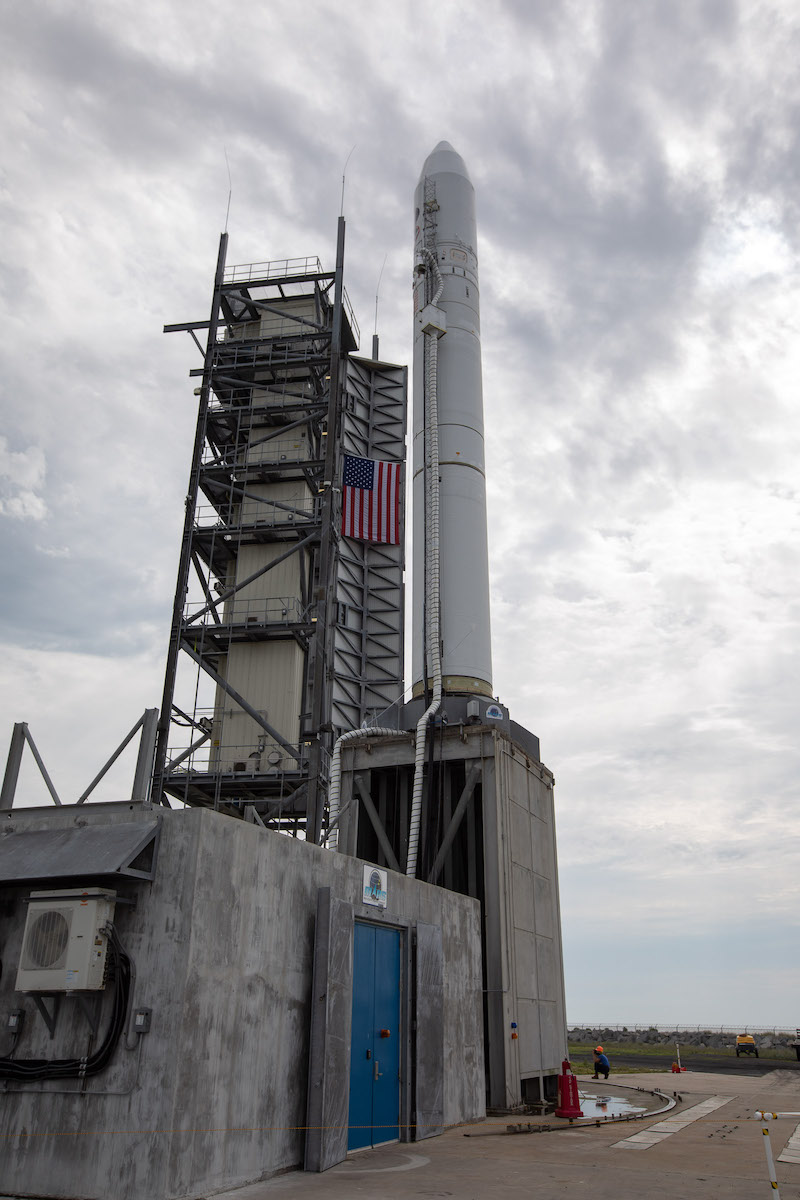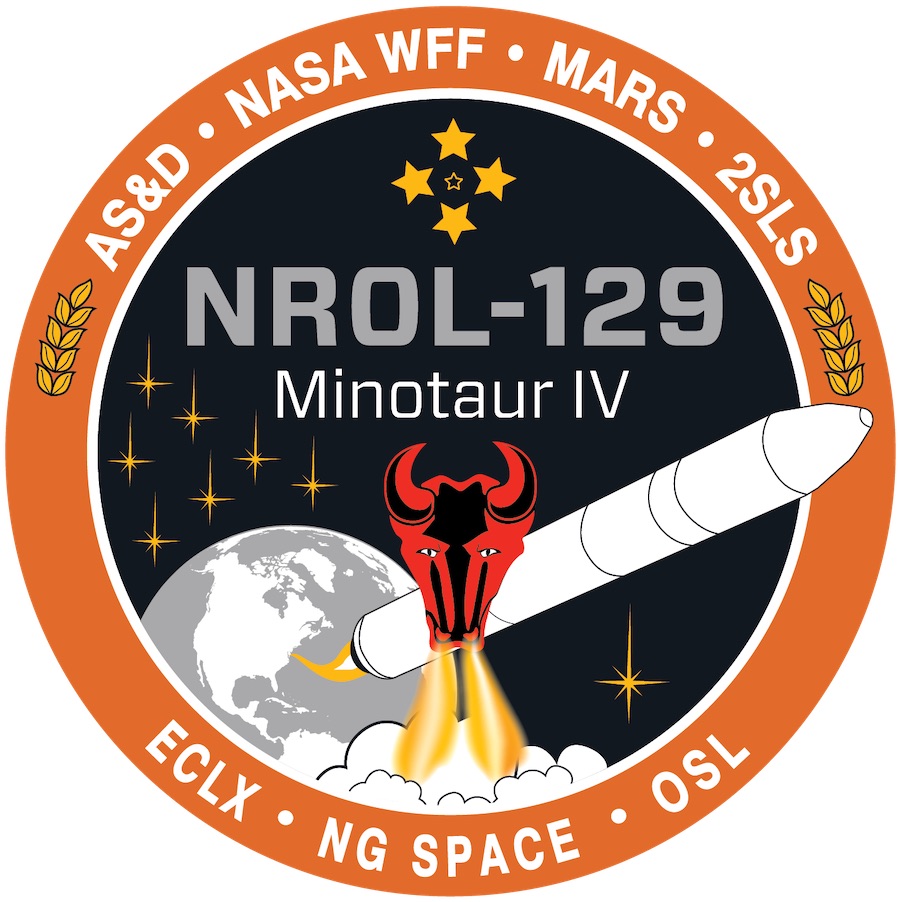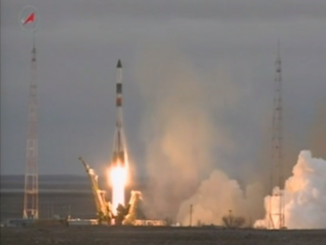
Four clandestine payloads for the National Reconnaissance Office are awaiting liftoff Wednesday from Wallops Island, Virginia, on a Minotaur 4 rocket powered by Cold War-era missile stages stored for more than 30 years until their conversion into a satellite launcher.
The solid-fueled Minotaur 4 launcher is scheduled for liftoff from Virginia’s Eastern Shore during a launch window opening at 9 a.m. EDT (1300 GMT) Wednesday. The 78-foot-tall (23.8-meter) rocket is expected to fly toward the southeast from the Virginia coast to place the NRO’s four payloads into low Earth orbit hundreds of miles above the planet, but the mission’s exact orbital parameters are classified.
The four payloads were designed, built and operated by the NRO, officials said, but NRO has not released details about the satellites. The NRO owns the U.S. government’s fleet of optical and radar surveillance satellites that feed information to U.S. intelligence agencies.
The mission Wednesday, designated NROL-129, “supports NRO’s overall national security mission to provide intelligence data to United States’ senior policy makers, the Intelligence Community and Department of Defense,” the NRO wrote in a press kit for the launch.
“The team is really excited and ready to get going here on this mission,” said Kurt Eberly, who oversees launch programs at Northrop Grumman, the prime contractor for the Minotaur program.
The Minotaur rocket family uses retired Minuteman and Peacekeeper missile motors originally built to launch nuclear weapons to targets around the world. The Department of Defense now uses the decommissioned missile parts for satellite launches, and engineers have added upper stages to do the additional work of accelerating payloads to the speeds required to enter orbit.
“We have successfully launched 26 Minotaur missions with our last Minotaur mission from Wallops in 2013,” said Lt. Col. Ryan Rose, chief of the small launch and targets division at the Space Force’s Space and Missile Systems Center, which procures Minotaur launch services and oversees launch operations for the NRO. “This will be our first U.S. Space Force mission and the first dedicated NRO mission from Wallops. We look forward to continuing to launch national priority satellites for our NRO partner.”
Of the 26 Minotaur launches since the rocket family’s debut in 2000, 16 have delivered satellites into orbit from launch pads at Wallops Island, Virginia, Vandenberg Air Force Base in California, Cape Canaveral Air Force Station in Florida, and Kodiak Island, Alaska. The other Minotaur flights launched on suborbital trajectories.
The Minotaur program boasts a 100 percent mission success record to date.
“We’re really focused on making this the tried-and-true small-to-medium launch vehicle for the Air Force, and when they really need to launch when they want it, and it needs to be reliable, then we want to be that provider for the NRO and other DOD agencies,” Eberly said in an interview with Spaceflight Now.
“I think what we offer is the ability to get to every orbit that they need from a variety of launch ranges,” Eberly said. “We’ve launched from Vandenberg, Cape Canaveral, here at Wallops. This will be the seventh out of Wallops. We’ve launched from Kodiak as well. So that just gives us the ability to fit different missions that the NRO and other DOD customers want to execute to different orbits.
“Different payloads need different processing facilities, and different availability from different ranges,” Eberly said. “So the ability to launch off of austere launch pads with these all-solid vehicles, it doesn’t take much. It’s really just a launch stool, and then a protected vault for our electrical ground support equipment. I think that’s pretty attractive to the Air Force.”
The government is paying Northrop Grumman $38 million for the NROL-129 launch. The launch contract for the NROL-129 mission was awarded to Northrop Grumman in 2017 through the military’s Orbital/Suborbital Program-3 procurement vehicle.

Northrop Grumman crews finished stacking the Minotaur 4 rocket July 2, when they craned the NROL-129 payloads on top of the launcher at pad 0B, which is part of the Mid-Atlantic Regional Spaceport run by the Virginia Commercial Space Flight Authority.
Located at NASA’s Wallops Flight Facility, the spaceport has three launch pads for orbital-class rockets — one used by the Minotaur family, one for Northrop Grumman’s larger Antares rocket used for resupply missions to the International Space Station, and a new launch complex designed for Rocket Lab’s Electron booster.
The NRO and Northrop Grumman have not disclosed the duration of the launch window Wednesday. There’s a 90 percent chance of favorable weather for launch Wednesday, according to forecasters at NASA’s Wallops Flight Facility.
The launch team first stacked the three lower stages of the Minotaur 4 rocket, each coming from stockpiles left over from the Air Force’s retired nuclear-tipped Peacekeeper missiles. On Friday, officials completed a mission dress rehearsal to practice countdown procedures, and officials convened a launch readiness review Monday to give approval for teams to continue with launch preparations.
The Peacekeeper rocket motors awaiting launch Wednesday were filled with pre-packed solid fuel between 1988 and 1990, then placed on alert in missile silos for 15 years until the military decommissioned the Peacekeeper in 2005, according to Col. Robert Bongiovi, director of the launch enterprise division at the Space and Missile Systems Center.
The Space Force maintains an “active aging surveillance program” to ensure decommissioned Peacekeeper and Minuteman missile motors can be made flightworthy in a short time when needed for a satellite launch. The missile motors are stored at Hill Air Force Base, Utah, and refurbished there before shipping out for launch preparations.
Eberly said the three Peacekeeper motors and the Minotaur 4’s fourth stage — an Orion 38 solid rocket motor produced commercially by Northrop Grumman — were shipped to Vandenberg for outfitting before they were transported to Wallops for stacking on pad 0B.
The Peacekeeper motors, designated the SR118, SR119 and SR120, will each fire for about one minute to boost the Minotaur 4 rocket into space. The launcher is expected to begin a coast phase a little more than three minutes after liftoff, then will later ignite the Orion 38 upper stage motor to inject the NROL-129 payloads into orbit.
Ground teams at Wallops took precautions to reduce the risk of spreading COVID-19, Eberly said.
“Our workforce takes this seriously,” Eberly said. “They’re exercising a lot of personal responsibility in their personal time to make sure that they stay safe, follow the guidelines, and stay out of risky situations. So far, knock on wood, we’ve been able to proceed and stay on schedule.”
The coronavirus pandemic caused Northrop Grumman to re-plan some operations associated with the NROL-129 mission.
“A lot of us engineers and management types can be teleworking from home, but the folks that are turning wrenches and running the system testing, and so on, need to be here (at Wallops), and they need to be touching the hardware, and in some instances they need to be in close proximity to each other,” Eberly said.
During some operations, such as installing ordnance on the rocket, procedures require two or more people within six feet of each other. In those cases, Northrop Grumman ensured the workers wore personal protective equipment, Eberly said.
“We’ve also done some other things like spaced-out operations, and done some remote monitoring, where otherwise we’d have people there in person,” he said. “It does cause us to have to plan things out further in advance, but hats off to our workforce. We’ve been able to stay on schedule for this launch and a couple other important launches that we’re working.”
Managers decided not to send as big of a crew to Wallops as would have been deployed to the launch site during normal times. Some of the Minotaur program’s engineers will remain at the company’s launch vehicle division headquarters in Chandler, Arizona, where Northrop Grumman set up a facility for the engineering support team to monitor the countdown and launch in real-time.
“So our engineers, a bunch are staying back there to be monitoring telemetry remotely and able to advise the folks who are in the control rooms here on the base,” Eberly said. “And then we spread out the team here. We used to be in one control room, kind of elbow-to-elbow, and now we’re using an additional control room where basically every other console is occupied, so we’re able to be spaced out quite a bit.”

The launch Wednesday will mark the first flight of a Minotaur rocket since a Minotaur 4 launch from Cape Canaveral in August 2017. Without a waiver, U.S. government policy requires the Minotaur rocket family only be used to launch military and intelligence-gathering satellites.
The policy is intended to keep government-furnished equipment, such as the retired Peacekeeper stages, from competing with privately-developed rockets in the small satellite launch market.
The Minotaur 4 rocket can carry payloads of up to 3,814 pounds (1,730 kilograms) into low Earth orbit, according to Northrop Grumman.
The last launch of a Minotaur rocket from Wallops Island was on Nov. 19, 2013, when a Minotaur 1 rocket — using Minuteman missile motors — took off with a cluster of small military research and technology demonstration satellites.
Pad 0B in Virginia has been the starting point for six Minotaur launches — five using Minotaur 1 rockets based on the Air Force’s Minuteman missile, and one with the Peacekeeper-derived Minotaur 5 booster, which adds a fifth stage on top of the Minotaur 4.
The Minotaur 4 and 5 rockets can carry heavier payloads than the commercial small satellite launchers developed by Rocket Lab, Virgin Orbit, Firefly Aerospace, Relativity Space, and numerous other firms fueled by venture capital financing.
Despite the Minotaur rocket’s low flight rate, Eberly said he thinks the program “fills a niche that is not really addressed very much for U.S. launchers.”
“Maybe (Europe’s) Vega is something similar in the international market, but the ability to launch two metric tons to low Earth orbit isn’t well-served, and I think a lot of space vehicles, and the kinds of new space vehicles that the NRO and others are producing, they just can’t always be served by the by the really small end of launch market,” Eberly said.
“So that’s where we can come in and offer a very dependable ride on a schedule, wherever they need us, and fill that bigger niche for payloads that just aren’t going to fit on a smaller vehicle, and they may not want to be on a rideshare, where you’re not able to drive the schedule, or if it’s a classified payload, you don’t want to be in a rideshare on a bigger vehicle,” he said.
“That’s where I think the dedicated launch aspect is very attracted to the NRO, where they can get just what they want. They can tailor the mission just the way they want, and then we can provide that service to them.”
Email the author.
Follow Stephen Clark on Twitter: @StephenClark1.



